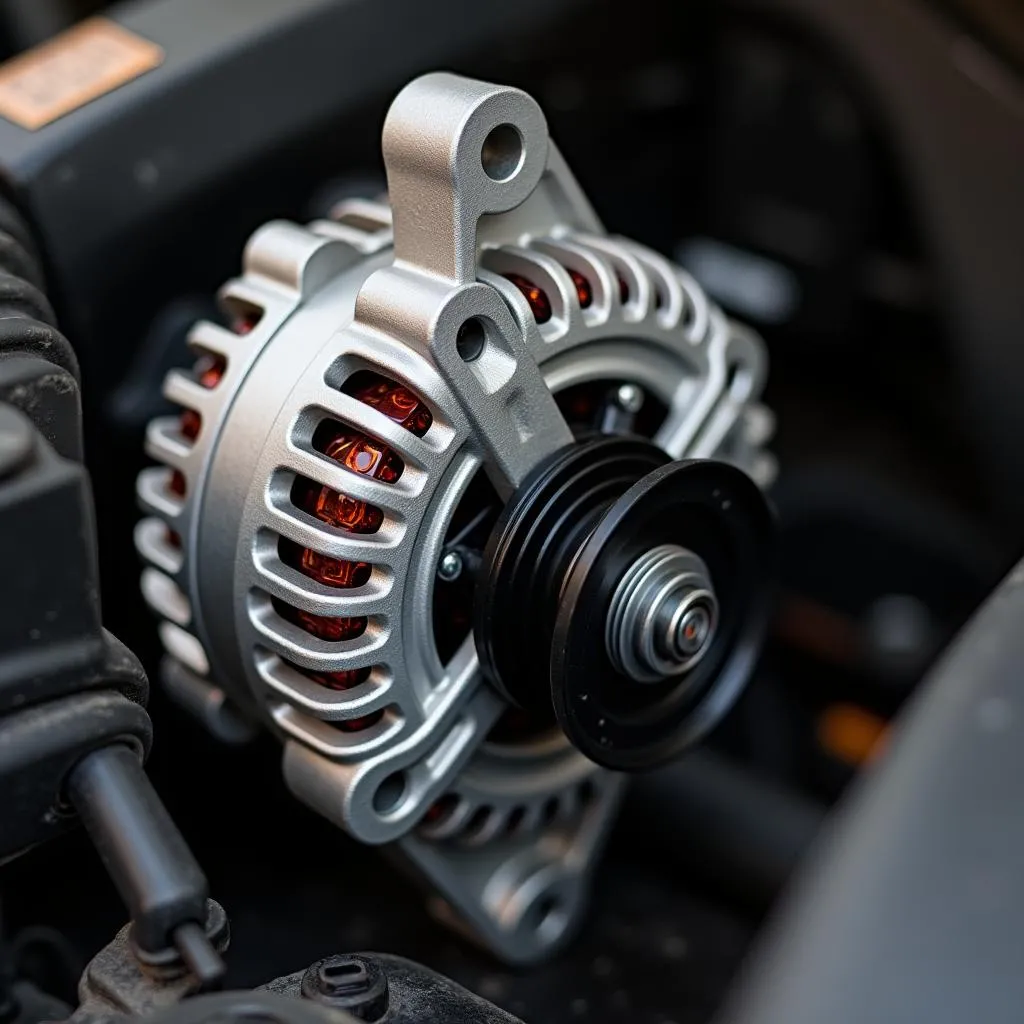The alternator belt, often called a V-belt or generator belt, is an essential component of every car. It might look insignificant, but without it, your vehicle would quickly grind to a halt. In this article, you’ll discover why this is the case and what you need to know about the alternator belt.
 A car's alternator with the drive belt attached
A car's alternator with the drive belt attached
What Does the Alternator Belt Do?
Imagine your car as a human body. The battery would be the heart, and the alternator belt would be the main artery. It transmits the engine’s mechanical energy to the alternator. The alternator then generates the electricity needed for all the car’s electrical components – from the lights and ignition to the radio and air conditioning.
Without a functioning alternator belt, the alternator cannot generate electricity. The battery will take over temporarily, but its capacity is limited. Once it’s depleted, the fun stops – and you’ll find yourself stranded on the roadside.
Incidentally, modern vehicles are often equipped with a serpentine belt. This drives not only the alternator but also other important components like the power steering pump and the water pump. A defective serpentine belt can therefore have far-reaching consequences and lead to engine damage.
How Do I Recognize a Defective Alternator Belt?
A worn alternator belt usually signals trouble with the following symptoms:
- Squealing noises from the engine bay, especially when starting or accelerating.
- Flickering lights from the headlights and dashboard illumination.
- Steering problems, as the power steering is not functioning correctly.
- Engine overheating, as the water pump is not circulating enough coolant.
- Illumination of the battery warning light on the dashboard.
If you notice one or more of these symptoms in your vehicle, it’s advisable to visit a workshop immediately. A defective alternator belt should be replaced as quickly as possible to prevent subsequent damage.
How Long Does an Alternator Belt Last?
The lifespan of an alternator belt depends on various factors, such as:
- Vehicle model and age: Belts wear out faster in older vehicles.
- Driving profile: Frequent short trips stress the belt more than long drives.
- Belt quality: High-quality belts generally last longer.
- Maintenance: Regular inspections and timely replacement of the belt extend its lifespan.
As a general rule, the alternator belt should be replaced approximately every 60,000 to 100,000 kilometers. However, it’s recommended to have the belt checked by a professional during every inspection.
What Does Replacing the Alternator Belt Cost?
The cost of replacing the alternator belt varies depending on the vehicle model and workshop. Generally, you can expect costs between 50 and 200 Euros. The replacement itself is relatively straightforward and quick.
 A mechanic replacing a car's drive belt
A mechanic replacing a car's drive belt
For Tech Enthusiasts: How the Alternator Works
The alternator is a generator that converts the engine’s mechanical energy into electrical energy. This happens through electromagnetic induction. Simply put:
- The alternator belt drives the alternator’s rotor shaft.
- Coils surrounded by a magnetic field are located on the rotor shaft.
- As the rotor turns, the magnetic field around the coils constantly changes.
- This change in the magnetic field generates an electrical voltage in the coils.
- The generated voltage is rectified via the alternator’s regulator and sent to the vehicle battery and the car’s electrical components.
Frequently Asked Questions About the Alternator Belt:
- Can I replace the alternator belt myself? In principle, this is possible if you have the necessary tools and expertise. However, it’s recommended to have the belt replaced by a professional workshop to ensure it’s correctly tensioned and installed.
- What’s the difference between a V-belt and a timing belt? The V-belt drives the engine’s accessory components, while the timing belt is responsible for controlling the valves. A broken timing belt can cause severe engine damage.
- Can I still drive with a broken alternator belt? No, this is not recommended. Without a functional alternator belt, the battery will no longer be charged and will gradually discharge. As soon as the battery is depleted, the vehicle will stop.
More Interesting Car Topics:
- Having trouble with your alternator? Read more about the costs for replacing an alternator here.
- You’ve installed a new alternator, but it’s not charging? Find possible causes and solutions here: New Alternator Not Charging.
- Want to know how long a V-belt lasts? Learn all about its lifespan and replacement interval in this article: How Long Does a V-Belt Last.
If you have any questions or issues regarding your vehicle, feel free to contact us. We’re here to assist you with our expert knowledge.

